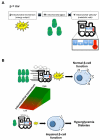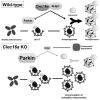Mitochondrial regulation of β-cell function: maintaining the momentum for insulin release
- PMID: 25659350
- PMCID: PMC4404204
- DOI: 10.1016/j.mam.2015.01.004
Mitochondrial regulation of β-cell function: maintaining the momentum for insulin release
Abstract
All forms of diabetes share the common etiology of insufficient pancreatic β-cell function to meet peripheral insulin demand. In pancreatic β-cells, mitochondria serve to integrate the metabolism of exogenous nutrients into energy output, which ultimately leads to insulin release. As such, mitochondrial dysfunction underlies β-cell failure and the development of diabetes. Mitochondrial regulation of β-cell function occurs through many diverse pathways, including metabolic coupling, generation of reactive oxygen species, maintenance of mitochondrial mass, and through interaction with other cellular organelles. In this chapter, we will focus on the importance of enzymatic regulators of mitochondrial fuel metabolism and control of mitochondrial mass to pancreatic β-cell function, describing how defects in these pathways ultimately lead to diabetes. Furthermore, we will examine the factors responsible for mitochondrial biogenesis and degradation and their roles in the balance of mitochondrial mass in β-cells. Clarifying the causes of β-cell mitochondrial dysfunction may inform new approaches to treat the underlying etiologies of diabetes.
Keywords: Diabetes; Islet; Metabolism; Mitochondria; Mitophagy; mtDNA.
Copyright © 2015 Elsevier Ltd. All rights reserved.
Figures



Similar articles
-
Role of mitochondria in beta-cell function and dysfunction.Adv Exp Med Biol. 2010;654:193-216. doi: 10.1007/978-90-481-3271-3_9. Adv Exp Med Biol. 2010. PMID: 20217499 Review.
-
Mitochondrial transcription factor B2 is essential for mitochondrial and cellular function in pancreatic β-cells.Mol Metab. 2017 May 19;6(7):651-663. doi: 10.1016/j.molmet.2017.05.005. eCollection 2017 Jul. Mol Metab. 2017. PMID: 28702322 Free PMC article.
-
The mitochondrial Atp8 mutation induces mitochondrial ROS generation, secretory dysfunction, and β-cell mass adaptation in conplastic B6-mtFVB mice.Endocrinology. 2012 Oct;153(10):4666-76. doi: 10.1210/en.2012-1296. Epub 2012 Aug 23. Endocrinology. 2012. PMID: 22919063
-
Transcribing β-cell mitochondria in health and disease.Mol Metab. 2017 May 31;6(9):1040-1051. doi: 10.1016/j.molmet.2017.05.014. eCollection 2017 Sep. Mol Metab. 2017. PMID: 28951827 Free PMC article. Review.
-
Mitochondrial dysfunction in pancreatic β cells.Trends Endocrinol Metab. 2012 Sep;23(9):477-87. doi: 10.1016/j.tem.2012.06.002. Epub 2012 Jul 4. Trends Endocrinol Metab. 2012. PMID: 22766318 Review.
Cited by
-
Metabolic response of Insulinoma 1E cells to glucose stimulation studied by fluorescence lifetime imaging.FASEB Bioadv. 2020 Jun 19;2(7):409-418. doi: 10.1096/fba.2020-00014. eCollection 2020 Jul. FASEB Bioadv. 2020. PMID: 32676581 Free PMC article.
-
Current Insight on the Role of Glucokinase and Glucokinase Regulatory Protein in Diabetes.Mini Rev Med Chem. 2024;24(7):674-688. doi: 10.2174/1389557523666230823151927. Mini Rev Med Chem. 2024. PMID: 37612862 Review.
-
Retrograde mitochondrial signaling governs the identity and maturity of metabolic tissues.Science. 2025 Apr 11;388(6743):eadf2034. doi: 10.1126/science.adf2034. Epub 2025 Apr 11. Science. 2025. PMID: 39913641
-
Gut microbiota promotes enteroendocrine cell maturation and mitochondrial function.bioRxiv [Preprint]. 2023 Nov 5:2023.09.27.558332. doi: 10.1101/2023.09.27.558332. bioRxiv. 2023. Update in: Development. 2024 Apr 15;151(8):dev202544. doi: 10.1242/dev.202544. PMID: 37961164 Free PMC article. Updated. Preprint.
-
Contribution of Oxidative Stress and Impaired Biogenesis of Pancreatic β-Cells to Type 2 Diabetes.Antioxid Redox Signal. 2019 Oct 1;31(10):722-751. doi: 10.1089/ars.2018.7656. Epub 2019 Jan 23. Antioxid Redox Signal. 2019. PMID: 30450940 Free PMC article.
References
-
- Anello M, Lupi R, Spampinato D, Piro S, Masini M, Boggi U, Del Prato S, Rabuazzo AM, Purrello F, Marchetti P. Functional and morphological alterations of mitochondria in pancreatic beta cells from type 2 diabetic patients. Diabetologia. 2005;48(2):282–289. - PubMed
-
- Brissova M, Shiota M, Nicholson WE, Gannon M, Knobel SM, Piston DW, Wright CV, Powers AC. Reduction in pancreatic transcription factor PDX-1 impairs glucose-stimulated insulin secretion. J Biol Chem. 2002;277(13):11225–11232. - PubMed
-
- Campbell CT, Kolesar JE, Kaufman BA. Mitochondrial transcription factor A regulates mitochondrial transcription initiation, DNA packaging, and genome copy number. Biochimica et biophysica acta. 2012;1819(9-10):921–929. - PubMed
Publication types
MeSH terms
Substances
Grants and funding
LinkOut - more resources
Full Text Sources
Other Literature Sources
Medical
Research Materials

